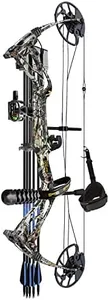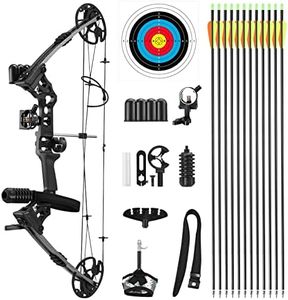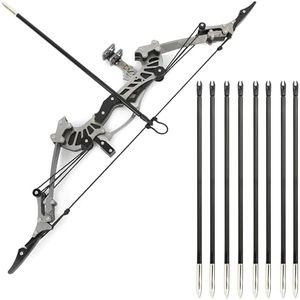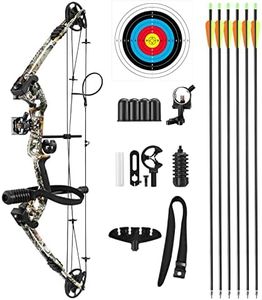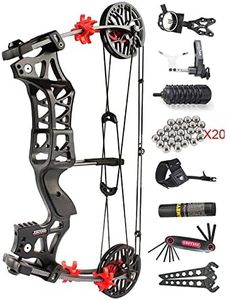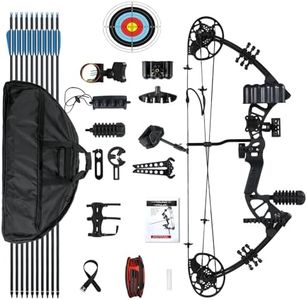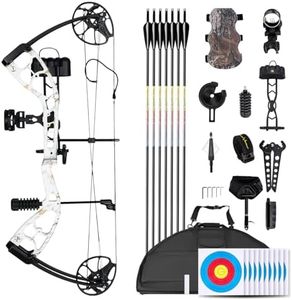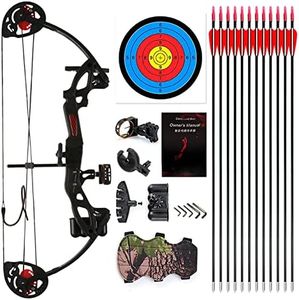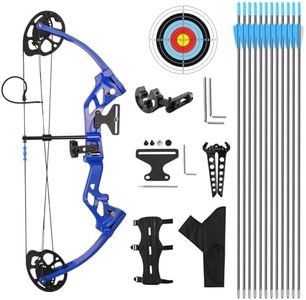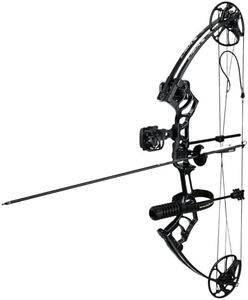We Use CookiesWe use cookies to enhance the security, performance,
functionality and for analytical and promotional activities. By continuing to browse this site you
are agreeing to our privacy policy
10 Best Beginner Compound Bows
From leading brands and best sellers available on the web.Buying Guide for the Best Beginner Compound Bows
Choosing a beginner compound bow is an exciting step into the world of archery. It's important to remember that as a beginner, your needs are different from those of advanced archers. You're looking for something that's easy to use, adjustable, and comfortable, so you can focus on learning good habits and enjoying the process. Before you make a purchase, think about how you'll use the bow, your physical strength, and your interest in different activities like target shooting or hunting. Test if possible, and read reviews from other beginners to learn about their experiences.Draw WeightDraw weight is the amount of force needed to pull the string back. This is important because it affects how hard the bow is to use and how much power your shot will have. Beginners should look for a bow with lower draw weight that's comfortable to pull back without straining. Usually, beginner bows offer a range like 10-70 pounds. If you're just starting out, a draw weight around 15-30 pounds is typically enough for target practice and learning form. Start low and only move up as you gain strength and skill, since going too heavy can cause bad habits and possible injuries.
Draw LengthDraw length refers to the distance you pull the bowstring back before shooting. Having the right draw length is essential for comfort and accuracy. Too short or too long, and your shot will suffer, and it might even cause discomfort. Bows for beginners often have adjustable draw lengths. Measure your arm span and divide by 2.5 to estimate your draw length. Choose a bow that can be adjusted to fit your needs, so you can change it as you grow or improve.
Axle-to-Axle LengthAxle-to-axle length is the distance between the two cams or wheels on the ends of the bow. This affects the overall size of the bow and how easy it is to handle. Shorter axle-to-axle bows (under 32 inches) are easier to maneuver, especially for younger or smaller users, but can be less stable. Longer bows (over 34 inches) offer more stability and may be better for those focusing on target archery. As a beginner, look for a mid-range axle-to-axle length, around 30-32 inches, which will balance stability and maneuverability.
Let-OffLet-off is a feature unique to compound bows that reduces the amount of weight you hold at full draw. Expressed as a percentage, high let-off (70-85%) means you hold less weight, so it's easier to aim for longer periods. For beginners, bows with higher let-off are ideal, as they reduce fatigue and allow you to work on your form and accuracy without quickly getting tired.
Overall Bow WeightThe overall weight of the bow affects how easy it is to handle, carry, and shoot comfortably. Lighter bows are great for younger users, people with less upper body strength, or anyone who plans to practice for long periods. However, bows that are too light can be harder to keep steady. As a beginner, try to pick a bow that feels comfortable to hold and manage, usually in the range of 2.5 to 4 pounds.
AdjustabilityBeginner bows often offer a lot of adjustability in both draw weight and draw length. This is crucial as you build strength or refine your form. Choosing a bow with a wide range of adjustments means you'll be able to keep using it as you grow or improve, saving you from needing to buy a new bow too soon. Make sure the bow you pick can be adjusted without special tools or complex processes, making it easy for you as a beginner.
Ease of Tuning and SetupSome bows are easier to set up and maintain than others. As a beginner, you’ll benefit from a bow that doesn't require specialized knowledge to tune, adjust, or swap accessories. Look for models that are described as 'ready to shoot' or that allow for simple changes, so you can spend less time tinkering and more time enjoying archery.
